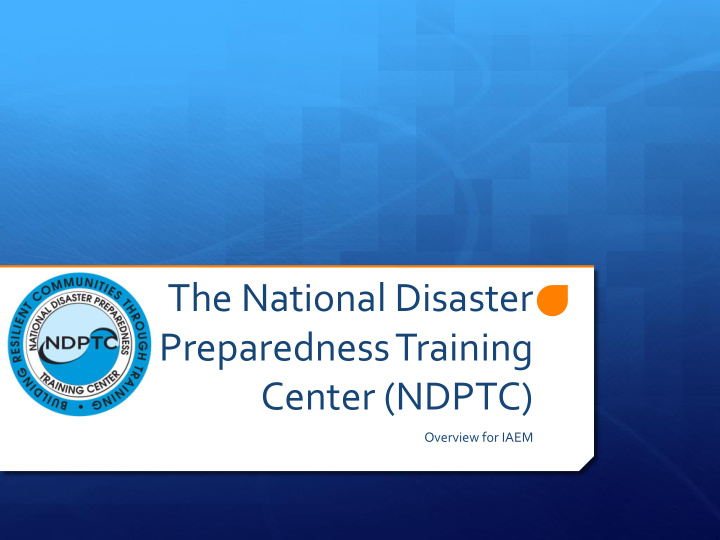



The National Disaster Preparedness Training Center (NDPTC) Overview for IAEM
NDPTC Staff on the Call Owen Shieh, Weather and Climate Program Manager Tom Bedard, Weather and Climate Program Specialist Ashley Maeshiro, Delivery Operations Coordinator Amanda Bates, Regional Training Coordinator Melissa Peneyra, Instructor Coordinator
What is NDPTC?
NDPTC’s Mission Uniquely positioned geographically and culturally, the NDPTC works collaboratively to develop and deliver training and education in the areas of disaster preparedness, response, and recovery to governmental, private, tribal, and non- profit entities, and under- represented/under-served communities.
Our Challenge http://www.nature.com/news/2008/080611/images/453840a-i1.0.jpg http://www.atp.nist.gov/eao/gcr02-841/fig3.jpg
Mobile Instructor-Led Training
Course Development Process Research and Contract Identify Training Outline Training Subject-Matter Need Content Experts Renew Course Submit for Develop and Material Every Federal Test Training 1 to 3 years Certification Course
Weather & Climate Training Courses Tornado Awareness (AWR-326) Winter Weather Hazards: Science and Preparedness (AWR-331) Hazardous Weather Preparedness for Campuses (AWR-332) Hurricane Awareness Climate Adaptation Strategies for Emergency Services
Other Hazards Training Topics Tsunamis Volcanoes Coastal Floods Natural Disasters (General)
Community-Based Training Topics Caregivers of Senior Citizens Security Professionals Community Leaders Coastal Communities Emergency Services Academic Campuses
Tool-Based Training Topics Unmanned Aircraft Systems Social Media Resilient Building Design Damage Assessments Disaster Communications Disaster Recovery Strategies
AWR-326 Tornado Awareness 810 Trained Mississippi Alabama Michigan Kentucky Wisconsin Ohio North Carolina Oklahoma Georgia New Hampshire Louisiana Pennsylvania Florida Colorado New Mexico New York Georgia Kansas Texas South Dakota
AWR-331 Winter Weather Hazards: Science and Preparedness 418 Trained Alabama Washington, D.C. Kansas Kentucky Michigan New Hampshire New Mexico New York Ohio Oklahoma Pennsylvania Wyoming
AWR-332 Hazardous Weather Preparedness for Campuses 116 Trained Hawai‘i Kansas Oklahoma Florida New Hampshire Washington, D.C.
Climate Adaptation for Emergency Services (Cert. Pending) 66 Trained Hawai‘i California Rhode Island
Hurricane Awareness (Cert. Pending) 62 Trained Hawai‘i O‘ahu Kauai Washington, D.C.
Available Accreditation Credits International Association of Emergency Managers (IAEM Currently all certified NDPTC courses are considered eligible by IAEM to provide training hours to Certified Emergency Managers and Affiliate Emergency Managers Certified Emergency Manager (CEM) or Affiliate Emergency Manager (AEM) Emergency Management (EM) or General Management (GM) training hours (Every 5 years)
AWR-217 Tsunami Awareness 6.5 EM AWR-228 Coastal Community Resilience 8 EM AWR-228C Coastal Community Resilience Custom 4 EM AWR-233 Volcanic Crises Awareness 12 EM AWR-308 Natural Disaster Awareness for Caregivers of Senior Citizens 3.5 EM AWR-310 Natural Disaster for Community Leaders 4 EM AWR-319 Leveraging Tools for Conducting Damage Assessments 5.5 EM AWR-322 Natural Disaster Awareness for Security Professionals 6.5 EM PER-304 Social Media for Disaster Response and Recovery 8 EM/GM PER-305 Coastal Flood Risk Reduction 6.5 EM PER-306 HURRIPLAN: Resilient Building Design for Coastal Communities 12 EM AWR-326 Tornado Awareness 6.5 EM
Course Registration Process Create an online profile 1) Select course and Register 2) Complete online Pre-test (unless Pre-test is set to be 3) completed in class) 4) Optional: Download Participant Guide
Host Agency Expectations State Administrative Agency – Training POC Approval Coordinate the facility Solicit participants Partner delivery Participants Anyone can attend our deliveries at no charge Non-US citizens Number of participants With partner delivery = 20 Without partner deliver = 30 Maximum
Scheduling Process At least 6 weeks lead time Training Request Form Set up registration Promotion 6 weeks pre-delivery 3 weeks pre-delivery Post-delivery
Complete course and pass the post-test with >90% Submit Resume, 1. Completed course questionnaire (provided to you after passing) 2. Shirt size 3. Successful teachback of a module selected by NDPTC to NDPTC staff by video-teleconference (VTC) or in person dependent upon location. Successful teachback of one or more modules in a course delivery (NDPTC will reimburse for travel expenses but is unpaid - no hourly wages) Based on evaluations, another teachback may be required in some instances
Instructor Qualifications Not federal employees (federally funded state and local employees are okay) Education or experience in relevant field and/or emergency management At least 10 years combined adult training and subject matter experience Previous training/teaching experience Required certificates: IS-100.b: Introduction to Incident Command System (1) IS-700.a: National Incident Management System System (NIMS) An Introduction (2)
Instructor Qualifications (cont.) A/V savvy (connect projector to computer, using PowerPoint and the clickers, etc) Ability to travel (including driving in unfamiliar places) Ability to follow instructions (the administrative side is our challenge here - completing paperwork, grading the post- tests, retesting, getting things sent back to the NDPTC office) Ability to lift necessary course materials (40-50lbs), sit and/or stand for longer than usual periods of time.
Expectations Timeline: Dependent on the course, the timeline from initial conversation to certification can vary Instructor has to initially complete the course and pending the success of a VTC, complete and in-class teachback Our newer courses can take longer since we do not have as many instructing opportunities yet. Once certification is complete, contracting can take approximately 10-14 business days. Once contracted: Instructors are hired on a contract basis, NDPTC does not require our instructors to instruct a minimum or maximum number of courses. We are a mobile training center and many of the instructor assignments will depend on geographic location of the course and the instructor.
Next Steps Take and complete course in your nearby area 1. Forward your resume to me and complete course 2. questionnaire Schedule VTC In-class teachback certification 3. contracting
Questions? Course Delivery Scheduling: Amanda Bates, batesa@hawaii.edu for Regions 1, 4, 7, and 8 Herman Utoafili, utoafili@hawaii.edu for Regions 3, 5, and 9 Jay Pascua, pascuajp@hawaii.edu for Regions 2, 6, and 10 Instructor Application Process: Melissa Peneyra, mpeneyra@hawaii.edu AEM/CEM Credits Ashley Maeshiro, abareng@hawaii.edu Course Development Owen Shieh, owen.h.shieh@noaa.gov http://wrnbywdt0216.eventbrite.com
Recommend
More recommend